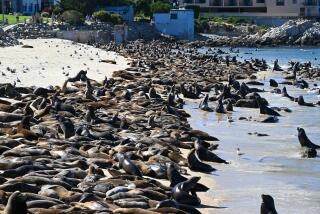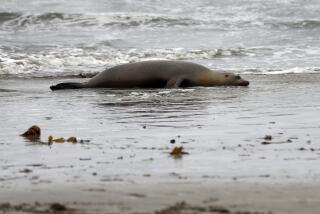Epileptic Sea Lion Finally Gets Tender-Loving Home in Houston
- Share via
LAGUNA BEACH — Her admirers describe her as “intelligent,” “beautiful,” “gentle” and “very people-oriented.”
The lady in question is Carly, a 5 1/2-year-old, 250-pound epileptic sea lion who has spent the last 18 months at Friends of the Sea Lion’s spacious Marine Mammal Center in Laguna Beach, awaiting a permanent home.
Because of her disease--controlled now by daily doses of fresh herring laced with phenobarbital--”Carly could never be returned to the ocean,” said Judi Jones, Marine Mammal Center director of operations.
And because of her epilepsy, zoos across the country weren’t interested in taking the sleek, silver-brown animal, Jones said.
Last week, however, Friends of the Sea Lion announced that Carly finally has a home. Last Tuesday, Carly and Cat, a sea lion from the Los Angeles Zoo, flew to Texas, courtesy of Continental Airlines. There, along with two other sea lions and two harbor seals, they will be the main attractions in the Houston Zoo’s just-completed $400,000 McGovern Mammal Marina.
Carly’s friendly personality was the main reason she was selected, said David Ruhter, the Houston Zoo’s curator of mammals.
“A lot of the animals that were offered to us were biters and didn’t like people at all,” Ruhter said. Carly, on the other hand, is “personable” and should be easy to train, he said.
Ruhter said he doesn’t plan to do circus tricks with Carly, such as having her jump through hoops. But he does want to be able to touch her easily and have her sit still for public presentations about sea lions.
At the Laguna Beach center last Monday, Carly showed reporters and a dozen children some of her stuff. At Jones’ urging, she sloshed in and out of the rock-lined pool, returning again and again to Jones’ side. However, she declined to “kiss” Jones, opting instead to stand on her rear flippers and touch her nose to Jones’ nose, said to be a favorite trick.
Rations Cut Back
Carly was “nervous,” Jones explained. To make sure she would not be airsick on her flight, Carly was being given less than her usual 4-pound-a-day ration of herring, so she sensed that something was up. She was hungry and she was also a little angry, Jones said.
Carly emphasized the point, slapping wet flippers past photographers and reporters, and barking, “Hrrmph.”
Jones and Bill Ford, center executive officer, emphasized that most of the 100 or so sick and injured sea lions that they rehabilitate each year are returned to the ocean--and not trained to be friendly to humans.
Said Ford: “We don’t interact socially with animals that are going to be released to the ocean because we don’t want them to think that all humans will be friendly to them--because they’re not.”
In an unusual pattern over the last month, the bodies of 49 sea lions drifted onto Orange County beaches. Federal biologists have said that evidence so far indicates that most of the sea lions died in the gill nets of halibut fishermen but that some were probably shot by other fishermen chasing squid off Huntington Beach.
Carly’s saga apparently did not involve fishermen. In 1984, when she was a year old, she somehow became stranded on a San Diego beach and was captured by Sea World, Jones said. She was then sent to a UC Santa Cruz animal behavior lab that has been studying the abilities of dolphins and sea lions.
“They think she hit her head up there. That’s when she started having seizures,” Jones said.
In August, 1987, Carly came to a rock-lined pool at Laguna Beach’s Marine Mammal Center. At the time, she was taking Dilantin, which partly controlled her seizures. But Jones said that when she switched Carly to phenobarbital (120 milligrams twice a day, delivered in the gills of a herring), the seizures stopped altogether. (An average dose for an adult epileptic human weighing 160 to 180 pounds is 180 milligrams a day, according to UCI Medical Center spokeswoman Elaine Beno.
Jones was excited that Carly finally has a permanent home but sad to see her leave.
“It’s like losing a friend. I wish that I could go with her,” she said. “I’ve seen a lot of sea lions. But she really has a pretty face.”
More to Read
Sign up for Essential California
The most important California stories and recommendations in your inbox every morning.
You may occasionally receive promotional content from the Los Angeles Times.










